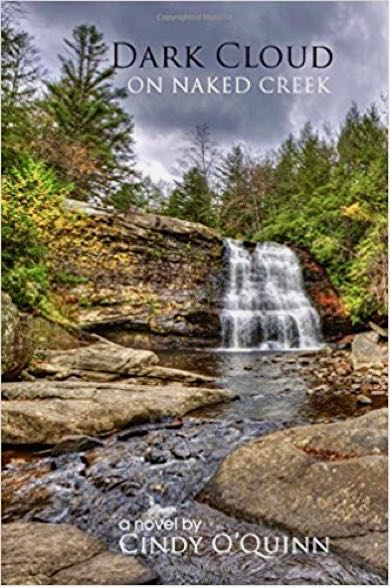Cindy O’Quinn, Dark Cloud on Naked Creek
reviewed by Alison McBain

Dark Cloud on Naked Creek Publisher: Maine Authors Publishing Date: 2016 Length: 226 pages ISBN: $12.95 |
One element of fiction that I enjoy is, actually, the nonfiction aspect of it. What I mean by this is that I always like to learn something new, something factual from the real world. For example, I love to read about a profession I’m not familiar with or a location I’ve never heard of or been to or, just generally, a way of life that is different from mine.
It was with this thought in mind that I picked up Cindy O’Quinn’s book Dark Cloud on Naked Creek. The blurb on the back of the book professes, “Tales of Appalachian folklore are woven throughout this story, which leads the readers to wonder if the monsters that visit their darkest nightmares might actually be real.” Having grown up on the West Coast, I know next to nothing about Appalachian folklore, so I was happy to dive right in to see what I could discover.
The narrative is very direct, and the voice is reminiscent of a person living an insular life in rural West Virginia. The main character is Afton, a nurse at a prison housing pedophiles, and the reader is introduced right away to her special talents when an inmate comes to her clinic complaining of chest pain. She lays hands on him and can “see” into his depraved thoughts. In the process, the inmate dies, and it is unclear whether Afton is responsible or not, if her disgust for him, in addition to her psychic powers, has brought about his end, or if he simply had a heart attack.
The mystery continues as the story unfolds. While the narrative leans towards a supernatural cause of events, it also starts out by treading a fine line between a psychic explanation for the strange happenings and a normal one. Many of Afton’s responses to events are explained through good or bad “feelings” she has about people and places, rather than a more overt type of magic. Many answers come to her in her dreams.
It’s not until a bit later in the story that the supernatural begins to become more pronounced over reality. That’s also when the reader learns about the “Cunnin’ Folk,” also referred to as “Appalachian Grannies.” They tend to be healers, who work with herbs and dreams and touch. Their premonitions can save lives or take them.
But the Folk are not the only ones who live nearby and possess special abilities; there are also the descendants of the Mingo tribe. Some are helpful, such as Phillip, a man who befriends Afton and also helps save her when her life is threatened. But some are only focused on gaining more power, such as Claire and Roy, a couple who want to gain the ancient tribal skill of skinwalking, the talent to shapeshift. But skinwalking is a dark magic, and a power that can only be achieved through harming others. When Afton finds that the ones she loves are on a collision course with these dark forces, she has to decide if she’s willing to risk her own life to save those of her friends and family.
This is not a fast-paced novel. If a reader is looking for explosions or car chases, they won’t be found here. I liked the idea of this slow unfolding of events; it’s different from a lot of modern fiction I’ve read recently, which jumps from action scene to action scene. Although there is forward movement in the story, a lot of the dilemmas are internal, and a lot of the action is slower. For example, one disaster that the reader learns has shaped Afton’s childhood is a house fire, but whether that fire is natural in origin or supernatural comes into question.
The narrative is told mostly in first person from Afton’s perspective, although it does delve into the heads of other key characters throughout the story. These changes in point of view tend to be brief, and I didn’t feel they detracted from the main storyline.
The description is fairly straightforward, told in a sparse Hemingway-style prose rather than ornate purple prose like Melville. The simplistic tone fits in with the background of the characters and creates a fairy tale/folklore feel to the story.
My only reservation is that I would have liked to explore additional descriptions of the setting, which is part of the unique background of this story and the reason I was first interested in picking up the book. I’m generally not one to quibble about spartan narrative or a simple plot, but I would have liked to see more fleshing out of the storyline in general. The book is told more in the style of a modern oral narrative rather than a literary novel, but I felt that expanding it a bit would have made for a more cohesive tale.
However, the book held my interest throughout the story, and I felt it was an easy read. I hope you enjoy reading Ms. O’Quinn’s novel.
Copyright © 2017 by Alison McBain

